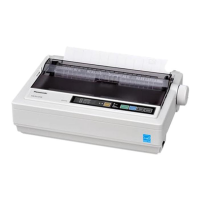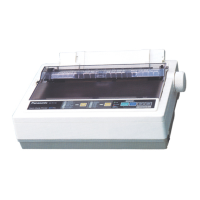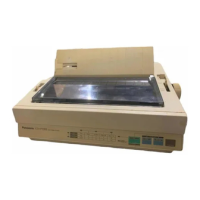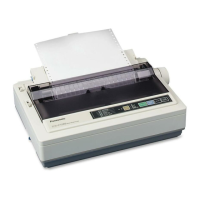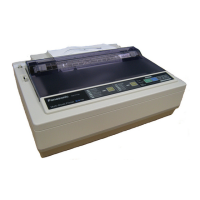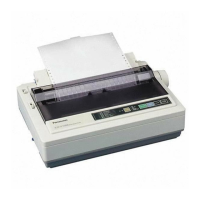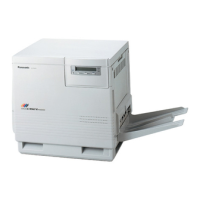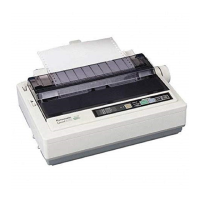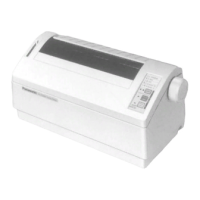Do you have a question about the Panasonic KX-P1123 and is the answer not in the manual?
Provides a general overview of the printer's capabilities and features.
Details on the printer's power needs and frequency.
Information on the available interface options for connecting the printer.
Lists the different font types supported by the printer.
Specifies the printer's compatibility with different software emulation modes.
Details the types of character sets supported by the printer.
Describes the dot diameter and matrix configuration of the printhead.
Specifies the maximum characters that can be printed on a single line.
Lists the printing speeds in characters per second for different modes.
Diagram and labels for the front view of the printer.
Diagram and labels for the top view of the printer.
Diagram and labels for the rear view of the printer.
Guidelines for selecting an appropriate environment for printer installation and operation.
Instructions for safely unpacking and checking the printer for any damage.
Step-by-step guide on how to power on the printer correctly.
Detailed instructions on how to install a new ribbon cassette into the printer.
Explains the different paper feed mechanisms and paths available for use.
Describes the function and usage of the paper feed selector, paper bail release, and head gap levers.
Instructions for loading different types of paper into the printer.
Instructions for loading continuous fanfold paper using the rear feed method.
Instructions for loading fanfold paper using the bottom feed path.
Instructions for loading single sheets of paper or envelopes using the friction feed.
How to perform a self-test to check printer functionality and print quality.
Guide on connecting the printer to a computer using parallel interface cables.
Explanation of the function and operation of the printer's front panel switches.
Details on using the Control Table for temporary changes to font, pitch, and form length.
Instructions for setting font, pitch, and form length using the Control Table.
How to apply character enhancements like bold, italic, and double width.
Procedure for setting the left and right margins for print alignment.
Information on storing and recalling printer settings using MACRO functions.
Steps to recall stored printer settings from MACRO memory.
How to print the current settings and stored MACRO configurations.
How to recall the printer's original factory default settings.
Explanation of the QUIET mode for reducing printing noise and its effect on speed.
Adjusting paper position using front panel switches.
Advances paper to the next top-of-form position.
Advances paper one line at a time or continuously.
Advances paper in small increments for precise positioning.
Reverses paper feed for specific micro line adjustments.
Function to advance fanfold paper perforation to the tear bar for easy page separation.
Lever function for loading or parking paper automatically.
Allows parking fanfold paper without removing it.
Procedure for loading single sheets or envelopes.
Steps to reload fanfold paper after using single sheets.
Stores and loads the first print line position for different paper feed methods.
Steps to access the printer's initial setup configuration mode.
Instructions for configuring various printer settings using the Control Table.
How to print the current configuration settings before making changes.
Procedure to restore all initial setup settings to their factory defaults.
Comprehensive list of all configurable items within the Initial Setup mode.
Controls whether download buffer is available for characters.
Enables or disables the Cut Sheet Feeder option.
Controls whether the printer's buzzer sounds for certain commands.
Sets how the zero character is displayed.
Enables or disables alternate graphic mode for IBM Proprinter X24.
Sets the data length for serial communication.
Sets the print direction for graphics.
Enables or disables skipping one inch of perforation.
Controls automatic line feed after carriage return.
Controls automatic carriage return in specific modes.
Enables or disables the paper out detector.
Selects the printer's baud rate for serial communication.
Sets the parity control for serial communication.
Selects the protocol for serial communication.
Sets buffer capacity for suspending data transfer.
Sets buffer capacity for resuming data transfer.
Sets signal polarity for DTR protocol.
Information about the paper out detector and its function.
Explains the overheat detector and its role in protecting the printhead.
Describes the overload detector for printhead movement blockages.
How to clear the printer's receive buffer without affecting other settings.
Basic concepts of computer-printer communication using coding schemes like ASCII.
Explanation of printer control codes and escape sequences.
Guidance on using commercial software and drivers for printer control.
How to send printer control commands directly from the computer keyboard using BASIC.
Incorporating control codes into BASIC programs for special printing features.
Entering ASCII codes in hexadecimal format using BASIC commands.
Examples of single-byte control commands.
Using specific BASIC commands for IBM PC compatibility with printers.
Overview of the printer's capabilities for customizing print modes.
Details on Draft and Letter Quality print modes and available fonts.
Explanation of the six different character pitches and their properties.
Instructions for designing and downloading custom characters using the 32K buffer option.
Guidance on optimizing buffer usage for character downloads.
Designing custom characters for the draft font using a dot matrix.
Designing custom characters for Letter Quality fonts.
How to print pictures, graphs, and charts using the printer's bit image modes.
Explanation of dot density and control commands for various resolutions.
Details on using the 8-pin bit image mode for graphics printing.
Details on using the 24-pin bit image mode for graphics printing.
Example program for setting dot density and printing graphics.
Commands for selecting letter quality, font style, and superscript/subscript.
Commands for setting character pitch and proportional spacing.
Commands for character enhancements like bold, italic, underline.
Commands for double strike, double width, and score printing.
Commands for alignment modes and character spacing.
Commands for selecting international and graphic character sets.
Commands for selecting bit image density and modes.
Commands for setting paper feed amounts in various increments.
Commands for executing paper feeds like line feed and form feed.
Commands for setting page length, margins, and skip perforation.
Commands for setting and executing horizontal tabs.
Commands for setting and executing vertical tabs.
Commands for carriage movement and line control.
Commands for buffer management and printer selection.
Commands for defining and selecting downloadable characters.
Commands for buzzer, escape sequences, and printer initialization.
Commands to select Letter Quality font printing.
Commands to select different font styles.
Commands for sub/superscript font printing.
Commands to set printing to 10 characters per inch.
Commands to set printing to 12 characters per inch.
Commands to set printing to 15 characters per inch.
Commands to set printing to 17 characters per inch.
Commands to set proportional spacing between characters.
Commands to set combined pitch and highlighting.
Commands to set printing to twice the horizontal dot density.
Commands to set double high printing.
Commands for single-line double wide character printing.
Commands to set double wide (elongated) character printing.
Commands to set double strike character printing.
Commands to set continuous underlining of characters.
Commands to set or cancel scores under text.
Commands for alignment modes and character spacing.
Commands to set character dot spacing.
Commands to select italic character printing.
Commands to select international or LEGAL character sets.
Command to select graphic character set 1.
Command to select graphic character set 2.
Commands to select alternate character sets.
Commands for 8-pin graphics at standard density.
Commands for 8-pin graphics at double density.
Commands for 8-pin graphics at double speed/double density.
Commands for 8-pin graphics at quadruple density.
Selects bit image modes based on AGM setting.
Selects bit image modes for 8-pin or 24-pin graphics.
Command to set paper feed amount to 1/8 inch.
Command to set paper feed amount to 1/6 inch.
Command to set programmable paper feed to n/60 inch.
Command to set programmable paper feed to n/180 inch.
Command to set programmable paper feed to n/360 inch.
Command to print data and execute a single line feed.
Command to feed paper to the next top-of-form position.
Prints buffer data and feeds paper n/180 inch.
Feeds paper n/180 inch in reverse direction.
Commands to set page length in inches.
Commands to set page length in number of lines.
Commands to set the position of the left margin.
Commands to set the position of the right margin.
Commands to set skip perforation at the bottom of the page.
Commands to set horizontal tabulations to specified values.
Command to execute horizontal tabs as designated.
Commands to set vertical tabulation to specified values.
Command to execute vertical tabs as designated.
Command to select one of eight channels in the Vertical Format Unit.
Commands to set tab positions for any channel in the VFU.
Prints data and backspaces one space.
Prints buffer data and designates next line start.
Moves the printhead to its home position.
Sets single direction printing mode.
Commands to set printing to half speed.
Moves the printhead to a relative horizontal position.
Moves the printhead to an absolute horizontal position.
Clears all data in the printer's buffer.
Selects the printer remotely to receive data.
Deselects printer remotely, disabling data reception.
Defines downloadable characters into specified RAM locations.
Command to sound the printer's buzzer.
Selects between ROM or downloaded character sets.
Copies internal ROM character sets to the downloadable font area.
Sounds the printer's buzzer for approximately 0.5 second.
First byte of multi-byte printer control codes.
Last byte of certain multi-byte printer control codes.
Initializes printer, clearing print buffer data.
Selects Cut Sheet Feeder mode ON/OFF.
Commands for selecting font quality, style, and sub/superscript.
Commands for setting character pitch and proportional spacing.
Commands for character enhancements like bold, italic, and double width.
Commands for selecting alternate character sets.
Commands for selecting bit image density and modes.
Commands for setting paper feed amounts.
Commands for executing paper feeds like line feed and form feed.
Commands for setting page length, margins, and skip perforation.
Commands for setting and executing horizontal tabs.
Commands for setting and executing vertical tabs.
Commands for carriage movement and line control.
Commands for buffer management and printer selection.
Command to define downloadable fonts.
Miscellaneous commands like buzzer, escape, and null.
Commands to select font and print quality.
Commands to select different font styles.
Commands for sub/superscript font printing.
Commands to set printing to 12 characters per inch.
Commands to set printing to 17 characters per inch.
Commands to set proportional spacing between characters.
Commands to set printing to twice the horizontal dot density.
Commands to set double strike character printing.
Commands for single-line double wide character printing.
Commands to set double wide (elongated) character printing.
Commands for double high, double wide, or both.
Commands to set continuous underlining of characters.
Commands to set continuous overlining of characters.
Command to select IBM Proprinter X24 character set 1.
Command to select IBM Proprinter X24 character set 2.
Commands for 8-pin graphics at standard density.
Commands for 8-pin graphics at double density.
Commands for 8-pin graphics at double speed/double density.
Commands for 8-pin graphics at quadruple density.
Selects bit image modes based on AGM setting.
Selects bit image modes for 8-pin or 24-pin graphics.
Command to set paper feed amount to 1/8 inch.
Command to set paper feed amount to 7/72 inch.
Executes line spacing set by ESC+"A"+n.
Command to set programmable paper feed to n/72 inch.
Command to set programmable paper feed to n/216 inch.
Selects line base unit for ESC+"3" and ESC+"]".
Automatically executes a Line Feed after a Carriage Return.
Command to print data and execute a single line feed.
Command to feed paper to the next top-of-form position.
Prints buffer data and feeds paper n/216 or n/180 inch.
Commands to set page length in inches.
Commands to set page length in number of lines.
Commands to set left and right margins.
Commands to set skip perforation at the bottom of the page.
Command to set the top of form position.
Commands to set horizontal tab stop positions.
Command to execute horizontal tabs.
Commands to set vertical tabulation positions.
Command to execute vertical tabs.
Resets all tabs to power-on settings.
Prints data and backspaces one space.
Prints buffer data and designates next line start.
Sets single direction printing mode.
Moves printhead to a relative horizontal position.
Clears all data in the printer's buffer.
Selects the printer remotely to receive data.
Deselects printer remotely, disabling data reception.
Defines downloadable characters into specified RAM locations.
Command to sound the printer's buzzer.
First byte of multi-byte printer control codes.
Last byte of certain multi-byte printer control codes.
Prints characters continuously from the All Character Chart.
Prints a single character from the All Character Chart.
Stops printing and enters OFF LINE mode.
Communication via parallel interface based on Centronics standard.
Details the pin configuration for the parallel interface connector.
Explanation of signals like STROBE, DATA, ACK, BUSY, and PAPER OUT.
Output signal indicating printer's ON LINE or OFF LINE state.
Input signal determining if LF is added to carriage return.
Signal ground connection.
Frame ground connection.
For evaluation only, not for external equipment power.
Input signal used to initialize or reset the printer.
Output signal indicating error or fault conditions.
Diagram showing timing signals for data transfer.
General precautions for printer care to extend its life.
Recommendations for cleaning the printer unit.
Information on ribbon yield, replacement, and troubleshooting.
Guidance on identifying and correcting common printer problems.
Table showing italic character mappings for Epson LQ-850.
Table displaying graphic characters for Set 1 in Epson LQ-850.
Table displaying graphic characters for Set 2 in Epson LQ-850.
Table showing character mappings for IBM Proprinter X24 Set 1.
Table showing character mappings for IBM Proprinter X24 Set 2.
Comprehensive chart of all characters for IBM Proprinter X24.
Table of international and LEGAL character sets.
Tables detailing proportional spacing widths for ASCII characters.
Proportional spacing data for Epson LQ-850 mode.
Proportional spacing data for IBM Proprinter X24 mode.
Graphic character data for Epson LQ-850 mode.
Graphic character data for Epson LQ-850 mode.
Graphic character data for IBM Proprinter X24 mode.
Details the structure of an index table entry.
Index table data for 10 cpi draft font.
Index table data for 12 cpi LQ font.
Blank matrix for designing draft characters (24x11).
Blank matrix for designing LQ characters (24x37).
Details paper specifications for fanfold paper.
Specifications for fanfold paper, including width and quality.
Specifications for single sheet paper, including width, height, and weight.
Recommendations for envelope sizes for printing.
Defines the printable areas on continuous paper.
Diagram showing printing area dimensions for continuous paper.
Diagram showing printing area dimensions for single sheets and envelopes.
Definitions of technical terms used in the manual.
Definition of American Standard Code for Information Interchange.
Definition of Beginner's All-purpose Symbolic Instruction Code.
Definition of data transmission speed unit.
Explanation of printing in both directions to increase speed.
Definition of the numbering system using 0s and 1s.
Definition of the smallest unit of information.
Definition of a temporary data storage area.
Definition of a unit of information equivalent to eight bits.
Definition of a set of characters, numbers, and symbols.
Commands from computer to printer for controlling functions.
Table on EZ Set Operator Panel for selecting features.
Abbreviation for characters per inch.
Abbreviation for characters per line.
Abbreviation for characters per second.
Control code returning printhead to left margin.
Definition of the decimal numbering system.
Meaning of previously set or factory settings.
Enhancement mode using two printhead passes for darker text.
Makes character height twice that of normal.
Makes character width twice that of normal.
User-designed character for printing.
Printer quality mode maximizing printing speed.
Enhancement for darker characters via half-speed printing.
Operating like another printer, e.g., Epson LQ-850 or IBM Proprinter X24.
Control code sequence initiating most printer commands.
Continuous paper with sprocket holes, separated by perforations.
Control code advancing paper one page.
Style and size of type.
Definition of the FORTRAN programming language.
Definition of the hexadecimal numbering system.
Process of resetting the printer to initial start-up conditions.
Connection between computer and printer systems.
Symbolic notation for Input/Output.
Control code advancing paper one line.
Acronym for Least Significant Bit.
Feature to save and recall printer functions.
Function to feed paper by one micro line.
Acronym for Most Significant Bit.
Print quality mode improving print quality but decreasing speed.
Printer state where communication with computer is not possible.
Printer state where communication with computer is possible.
Prints a continuous line above characters.
Connection method for parallel communication.
Method for checking data transfer accuracy.
Definition of the PASCAL programming language.
Indicates tear position on fanfold paper.
Number of characters per inch.
Rubber roller backing for paper during printing.
Software that controls printer functions and features.
Printing method adjusting space based on character width.
Rules for communication over serial interfaces.
Feature reducing printing noise.
Memory for storing print data, cleared when printer is off.
Memory for predefined characters and operating information, not cleared when off.
Method for testing printer operation.
Connection method for serial communication.
Cable with metal wrap for radio interference protection.
Area before/after perforation where nothing is printed.
Joining two or more bytes into a single command.
First line position on paper for alignment.
Prints left-to-right only, slower speed but better vertical alignment.
Provides a general overview of the printer's capabilities and features.
Details on the printer's power needs and frequency.
Information on the available interface options for connecting the printer.
Lists the different font types supported by the printer.
Specifies the printer's compatibility with different software emulation modes.
Details the types of character sets supported by the printer.
Describes the dot diameter and matrix configuration of the printhead.
Specifies the maximum characters that can be printed on a single line.
Lists the printing speeds in characters per second for different modes.
Diagram and labels for the front view of the printer.
Diagram and labels for the top view of the printer.
Diagram and labels for the rear view of the printer.
Guidelines for selecting an appropriate environment for printer installation and operation.
Instructions for safely unpacking and checking the printer for any damage.
Step-by-step guide on how to power on the printer correctly.
Detailed instructions on how to install a new ribbon cassette into the printer.
Explains the different paper feed mechanisms and paths available for use.
Describes the function and usage of the paper feed selector, paper bail release, and head gap levers.
Instructions for loading different types of paper into the printer.
Instructions for loading continuous fanfold paper using the rear feed method.
Instructions for loading fanfold paper using the bottom feed path.
Instructions for loading single sheets of paper or envelopes using the friction feed.
How to perform a self-test to check printer functionality and print quality.
Guide on connecting the printer to a computer using parallel interface cables.
Explanation of the function and operation of the printer's front panel switches.
Details on using the Control Table for temporary changes to font, pitch, and form length.
Instructions for setting font, pitch, and form length using the Control Table.
How to apply character enhancements like bold, italic, and double width.
Procedure for setting the left and right margins for print alignment.
Information on storing and recalling printer settings using MACRO functions.
Steps to recall stored printer settings from MACRO memory.
How to print the current settings and stored MACRO configurations.
How to recall the printer's original factory default settings.
Explanation of the QUIET mode for reducing printing noise and its effect on speed.
Adjusting paper position using front panel switches.
Advances paper to the next top-of-form position.
Advances paper one line at a time or continuously.
Advances paper in small increments for precise positioning.
Reverses paper feed for specific micro line adjustments.
Function to advance fanfold paper perforation to the tear bar for easy page separation.
Lever function for loading or parking paper automatically.
Allows parking fanfold paper without removing it.
Procedure for loading single sheets or envelopes.
Steps to reload fanfold paper after using single sheets.
Stores and loads the first print line position for different paper feed methods.
Steps to access the printer's initial setup configuration mode.
Instructions for configuring various printer settings using the Control Table.
How to print the current configuration settings before making changes.
Procedure to restore all initial setup settings to their factory defaults.
Comprehensive list of all configurable items within the Initial Setup mode.
Controls whether download buffer is available for characters.
Enables or disables the Cut Sheet Feeder option.
Controls whether the printer's buzzer sounds for certain commands.
Sets how the zero character is displayed.
Enables or disables alternate graphic mode for IBM Proprinter X24.
Sets the data length for serial communication.
Sets the print direction for graphics.
Enables or disables skipping one inch of perforation.
Controls automatic line feed after carriage return.
Controls automatic carriage return in specific modes.
Enables or disables the paper out detector.
Selects the printer's baud rate for serial communication.
Sets the parity control for serial communication.
Selects the protocol for serial communication.
Sets buffer capacity for suspending data transfer.
Sets buffer capacity for resuming data transfer.
Sets signal polarity for DTR protocol.
Information about the paper out detector and its function.
Explains the overheat detector and its role in protecting the printhead.
Describes the overload detector for printhead movement blockages.
How to clear the printer's receive buffer without affecting other settings.
Basic concepts of computer-printer communication using coding schemes like ASCII.
Explanation of printer control codes and escape sequences.
Guidance on using commercial software and drivers for printer control.
How to send printer control commands directly from the computer keyboard using BASIC.
Incorporating control codes into BASIC programs for special printing features.
Entering ASCII codes in hexadecimal format using BASIC commands.
Examples of single-byte control commands.
Using specific BASIC commands for IBM PC compatibility with printers.
Overview of the printer's capabilities for customizing print modes.
Details on Draft and Letter Quality print modes and available fonts.
Explanation of the six different character pitches and their properties.
Instructions for designing and downloading custom characters using the 32K buffer option.
Guidance on optimizing buffer usage for character downloads.
Designing custom characters for the draft font using a dot matrix.
Designing custom characters for Letter Quality fonts.
How to print pictures, graphs, and charts using the printer's bit image modes.
Explanation of dot density and control commands for various resolutions.
Details on using the 8-pin bit image mode for graphics printing.
Details on using the 24-pin bit image mode for graphics printing.
Example program for setting dot density and printing graphics.
Commands for selecting letter quality, font style, and superscript/subscript.
Commands for setting character pitch and proportional spacing.
Commands for character enhancements like bold, italic, underline.
Commands for double strike, double width, and score printing.
Commands for alignment modes and character spacing.
Commands for selecting international and graphic character sets.
Commands for selecting bit image density and modes.
Commands for setting paper feed amounts in various increments.
Commands for executing paper feeds like line feed and form feed.
Commands for setting page length, margins, and skip perforation.
Commands for setting and executing horizontal tabs.
Commands for setting and executing vertical tabs.
Commands for carriage movement and line control.
Commands for buffer management and printer selection.
Commands for defining and selecting downloadable characters.
Commands for buzzer, escape sequences, and printer initialization.
Commands to select Letter Quality font printing.
Commands to select different font styles.
Commands for sub/superscript font printing.
Commands to set printing to 10 characters per inch.
Commands to set printing to 12 characters per inch.
Commands to set printing to 15 characters per inch.
Commands to set printing to 17 characters per inch.
Commands to set proportional spacing between characters.
Commands to set combined pitch and highlighting.
Commands to set printing to twice the horizontal dot density.
Commands to set double high printing.
Commands for single-line double wide character printing.
Commands to set double wide (elongated) character printing.
Commands to set double strike character printing.
Commands to set continuous underlining of characters.
Commands to set or cancel scores under text.
Commands for alignment modes and character spacing.
Commands to set character dot spacing.
Commands to select italic character printing.
Commands to select international or LEGAL character sets.
Command to select graphic character set 1.
Command to select graphic character set 2.
Commands to select alternate character sets.
Commands for 8-pin graphics at standard density.
Commands for 8-pin graphics at double density.
Commands for 8-pin graphics at double speed/double density.
Commands for 8-pin graphics at quadruple density.
Selects bit image modes based on AGM setting.
Selects bit image modes for 8-pin or 24-pin graphics.
Command to set paper feed amount to 1/8 inch.
Command to set paper feed amount to 1/6 inch.
Command to set programmable paper feed to n/60 inch.
Command to set programmable paper feed to n/180 inch.
Command to set programmable paper feed to n/360 inch.
Command to print data and execute a single line feed.
Command to feed paper to the next top-of-form position.
Prints buffer data and feeds paper n/180 inch.
Feeds paper n/180 inch in reverse direction.
Commands to set page length in inches.
Commands to set page length in number of lines.
Commands to set the position of the left margin.
Commands to set the position of the right margin.
Commands to set skip perforation at the bottom of the page.
Commands to set horizontal tabulations to specified values.
Command to execute horizontal tabs as designated.
Commands to set vertical tabulation to specified values.
Command to execute vertical tabs as designated.
Command to select one of eight channels in the Vertical Format Unit.
Commands to set tab positions for any channel in the VFU.
Prints data and backspaces one space.
Prints buffer data and designates next line start.
Moves the printhead to its home position.
Sets single direction printing mode.
Commands to set printing to half speed.
Moves the printhead to a relative horizontal position.
Moves the printhead to an absolute horizontal position.
Clears all data in the printer's buffer.
Selects the printer remotely to receive data.
Deselects printer remotely, disabling data reception.
Defines downloadable characters into specified RAM locations.
Command to sound the printer's buzzer.
Selects between ROM or downloaded character sets.
Copies internal ROM character sets to the downloadable font area.
Sounds the printer's buzzer for approximately 0.5 second.
First byte of multi-byte printer control codes.
Last byte of certain multi-byte printer control codes.
Initializes printer, clearing print buffer data.
Selects Cut Sheet Feeder mode ON/OFF.
Commands for selecting font quality, style, and sub/superscript.
Commands for setting character pitch and proportional spacing.
Commands for character enhancements like bold, italic, and double width.
Commands for selecting alternate character sets.
Commands for selecting bit image density and modes.
Commands for setting paper feed amounts.
Commands for executing paper feeds like line feed and form feed.
Commands for setting page length, margins, and skip perforation.
Commands for setting and executing horizontal tabs.
Commands for setting and executing vertical tabs.
Commands for carriage movement and line control.
Commands for buffer management and printer selection.
Command to define downloadable fonts.
Miscellaneous commands like buzzer, escape, and null.
Commands to select font and print quality.
Commands to select different font styles.
Commands for sub/superscript font printing.
Commands to set printing to 12 characters per inch.
Commands to set printing to 17 characters per inch.
Commands to set proportional spacing between characters.
Commands to set printing to twice the horizontal dot density.
Commands to set double strike character printing.
Commands for single-line double wide character printing.
Commands to set double wide (elongated) character printing.
Commands for double high, double wide, or both.
Commands to set continuous underlining of characters.
Commands to set continuous overlining of characters.
Command to select IBM Proprinter X24 character set 1.
Command to select IBM Proprinter X24 character set 2.
Commands for 8-pin graphics at standard density.
Commands for 8-pin graphics at double density.
Commands for 8-pin graphics at double speed/double density.
Commands for 8-pin graphics at quadruple density.
Selects bit image modes based on AGM setting.
Selects bit image modes for 8-pin or 24-pin graphics.
Command to set paper feed amount to 1/8 inch.
Command to set paper feed amount to 7/72 inch.
Executes line spacing set by ESC+"A"+n.
Command to set programmable paper feed to n/72 inch.
Command to set programmable paper feed to n/216 inch.
Selects line base unit for ESC+"3" and ESC+"]".
Automatically executes a Line Feed after a Carriage Return.
Command to print data and execute a single line feed.
Command to feed paper to the next top-of-form position.
Prints buffer data and feeds paper n/216 or n/180 inch.
Commands to set page length in inches.
Commands to set page length in number of lines.
Commands to set left and right margins.
Commands to set skip perforation at the bottom of the page.
Command to set the top of form position.
Commands to set horizontal tab stop positions.
Command to execute horizontal tabs.
Commands to set vertical tabulation positions.
Command to execute vertical tabs.
Resets all tabs to power-on settings.
Prints data and backspaces one space.
Prints buffer data and designates next line start.
Sets single direction printing mode.
Moves printhead to a relative horizontal position.
Clears all data in the printer's buffer.
Selects the printer remotely to receive data.
Deselects printer remotely, disabling data reception.
Defines downloadable characters into specified RAM locations.
Command to sound the printer's buzzer.
First byte of multi-byte printer control codes.
Last byte of certain multi-byte printer control codes.
Prints characters continuously from the All Character Chart.
Prints a single character from the All Character Chart.
Stops printing and enters OFF LINE mode.
Communication via parallel interface based on Centronics standard.
Details the pin configuration for the parallel interface connector.
Explanation of signals like STROBE, DATA, ACK, BUSY, and PAPER OUT.
Output signal indicating printer's ON LINE or OFF LINE state.
Input signal determining if LF is added to carriage return.
Signal ground connection.
Frame ground connection.
For evaluation only, not for external equipment power.
Input signal used to initialize or reset the printer.
Output signal indicating error or fault conditions.
Diagram showing timing signals for data transfer.
General precautions for printer care to extend its life.
Recommendations for cleaning the printer unit.
Information on ribbon yield, replacement, and troubleshooting.
Guidance on identifying and correcting common printer problems.
Table showing italic character mappings for Epson LQ-850.
Table displaying graphic characters for Set 1 in Epson LQ-850.
Table displaying graphic characters for Set 2 in Epson LQ-850.
Table showing character mappings for IBM Proprinter X24 Set 1.
Table showing character mappings for IBM Proprinter X24 Set 2.
Comprehensive chart of all characters for IBM Proprinter X24.
Table of international and LEGAL character sets.
Tables detailing proportional spacing widths for ASCII characters.
Proportional spacing data for Epson LQ-850 mode.
Proportional spacing data for IBM Proprinter X24 mode.
Graphic character data for Epson LQ-850 mode.
Graphic character data for Epson LQ-850 mode.
Graphic character data for IBM Proprinter X24 mode.
Details the structure of an index table entry.
Index table data for 10 cpi draft font.
Index table data for 12 cpi LQ font.
Blank matrix for designing draft characters (24x11).
Blank matrix for designing LQ characters (24x37).
Details paper specifications for fanfold paper.
Specifications for fanfold paper, including width and quality.
Specifications for single sheet paper, including width, height, and weight.
Recommendations for envelope sizes for printing.
Defines the printable areas on continuous paper.
Diagram showing printing area dimensions for continuous paper.
Diagram showing printing area dimensions for single sheets and envelopes.
Definitions of technical terms used in the manual.
Definition of American Standard Code for Information Interchange.
Definition of Beginner's All-purpose Symbolic Instruction Code.
Definition of data transmission speed unit.
Explanation of printing in both directions to increase speed.
Definition of the numbering system using 0s and 1s.
Definition of the smallest unit of information.
Definition of a temporary data storage area.
Definition of a unit of information equivalent to eight bits.
Definition of a set of characters, numbers, and symbols.
Commands from computer to printer for controlling functions.
Table on EZ Set Operator Panel for selecting features.
Abbreviation for characters per inch.
Abbreviation for characters per line.
Abbreviation for characters per second.
Control code returning printhead to left margin.
Definition of the decimal numbering system.
Meaning of previously set or factory settings.
Enhancement mode using two printhead passes for darker text.
Makes character height twice that of normal.
Makes character width twice that of normal.
User-designed character for printing.
Printer quality mode maximizing printing speed.
Enhancement for darker characters via half-speed printing.
Operating like another printer, e.g., Epson LQ-850 or IBM Proprinter X24.
Control code sequence initiating most printer commands.
Continuous paper with sprocket holes, separated by perforations.
Control code advancing paper one page.
Style and size of type.
Definition of the FORTRAN programming language.
Definition of the hexadecimal numbering system.
Process of resetting the printer to initial start-up conditions.
Connection between computer and printer systems.
Symbolic notation for Input/Output.
Control code advancing paper one line.
Acronym for Least Significant Bit.
Feature to save and recall printer functions.
Function to feed paper by one micro line.
Acronym for Most Significant Bit.
Print quality mode improving print quality but decreasing speed.
Printer state where communication with computer is not possible.
Printer state where communication with computer is possible.
Prints a continuous line above characters.
Connection method for parallel communication.
Method for checking data transfer accuracy.
Definition of the PASCAL programming language.
Indicates tear position on fanfold paper.
Number of characters per inch.
Rubber roller backing for paper during printing.
Software that controls printer functions and features.
Printing method adjusting space based on character width.
Rules for communication over serial interfaces.
Feature reducing printing noise.
Memory for storing print data, cleared when printer is off.
Memory for predefined characters and operating information, not cleared when off.
Method for testing printer operation.
Connection method for serial communication.
Cable with metal wrap for radio interference protection.
Area before/after perforation where nothing is printed.
Joining two or more bytes into a single command.
First line position on paper for alignment.
Prints left-to-right only, slower speed but better vertical alignment.
| Type | Dot Matrix Printer |
|---|---|
| Print Width | 80 columns |
| Interface | Parallel |
| Number of Pins | 24 |
| Max. Resolution | 360 x 360 dpi |
| Noise Level | 55 dB |
| Print Technology | Impact Dot Matrix |
| Paper Path | Friction feed |

